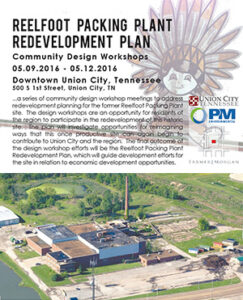Public Input is Key to Successful Brownfield Projects
The public has been invited to give input on the fate of the vacant Reelfoot Packing Plant in Union City, Tennessee.
Thanks in part to a $400,000 EPA brownfield grant, the once booming, now vacant and abandoned packaging plant is closer to being redeveloped. Community involvement is a key component to all EPA grants, and the public is encouraged to participate throughout the process.
PM Environmental was contracted by the City of Union City as their consultant for the grant and PM, along with the planning firm Farmer/Morgan, LLC will be preparing redevelopment scenarios for the plant. A series of public meetings, known as “charrettes”, will be held from May 9 – 12 in Union City, to offer the opportunity for anyone to propose ideas on the next life for the packing plant property.
Below, John Hargraves, PM’s Brownfield Regional Manager, answers some common questions about the charrette process:
Is public participation necessary for a brownfield project to happen?
Our experience has been that successful redevelopment planning will include some sort of public comment and participation.
Who is usually called to the meeting?
The public as a whole is invited to the charrette. Usually, a focus is put on specific citizens that either live in the neighborhood where the site is located, or have some other vested interest in the property to participate.
In which phases of a Brownfield project does the public participate.
The public is invited to participate in all phases. Typically, there are public meetings to discuss sites and progress. In the case of these charrettes, the public will be participating in visioning future land use for properties where there is no set redevelopment.
How does public participation benefit a project?
There’s a variety of benefits. It can consolidate groups that could normally be at odds, such as political, community action, religious, and grass roots organizations, together under one vision. It can inspire developers to invest in a community that has a vision.
Have any projects ever changed significantly based on public suggestions?
The interesting part of this charrette process is there are no real set in stone outcomes expected at the beginning. The land use visioning is driven by the input from the public. We have seen many imaginative ideas for a creative reuse of property. Vacant riverfronts have been imagined with amphitheaters and marinas, blighted buildings with farmer’s markets and splash parks.
What if the public opinion is divided? What happens?
That’s the beauty of a charrette process. It’s not meant to always bring agreement to a specific land use, but to pull out all of the ideas that are in the minds of the citizens and bring all of the different voices together to agree that something needs to be done. The more ideas, the better! Renderings of the ideas are completed as part of the final reports to show a variety of options and visions.
Why do you think this was included as a component in brownfield projects?
For Union City, the Reelfoot Packing Plant is the key site in the city for redevelopment. Funding was budgeted specifically in their brownfield grant to conduct this planning. For other communities, this concept can evolve and become a priority later in the program. For example, Starkville, Mississippi used much of their EPA assessment grant on property in the vicinity of an underserved corridor on Highway 182. Near the end of the grant window, it was decided that the remaining funds would be used to do additional visioning for the corridor where some successful redevelopments were in the process of being completed. Either way, it provides ideas for ways a specific property or properties can be redeveloped to benefit the entire community and neighborhood.
News Details
Date
May 30, 2017

